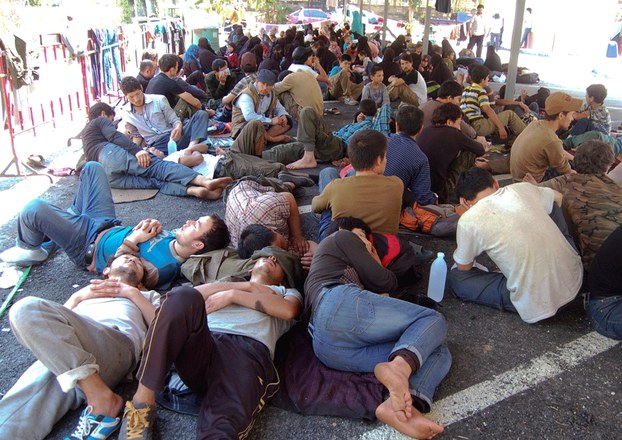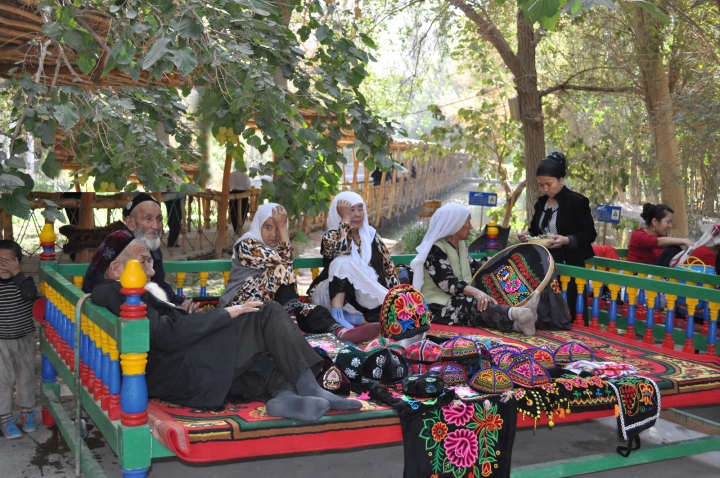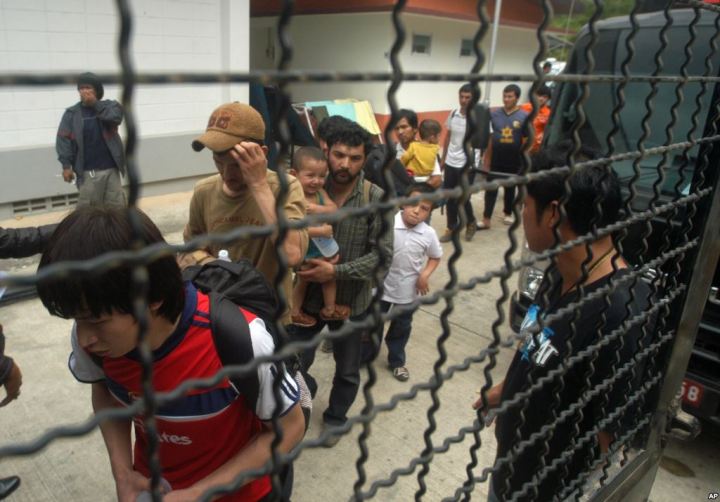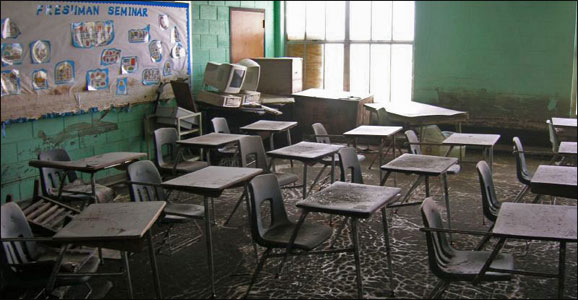Please note: due to the severe restrictions placed on journalists in China, the majority of media depicting the fallout from my case study will be from Turkish reactions, as there have been no reactions from those in Xinjiang published to Western media that I can find.

This map illustrates one of the areas I will be discussing: the province of Xinjiang in China.
In 2014, Thailand captured and held around three hundred Uyghur people fleeing China. In June of 2015, around 170 were sent to Turkey – the location they wanted to go to escape racially and religiously motivated persecution in China. In July of 2015, after pressure from China, the remaining Uyghur being detained were sent back to China.

Uyghur illegal immigrants caught on the Thailand/Malaysian border.
The issue of race in China is more than just an issue of mistakenly applying biology to distinct groups of people – it’s an issue of ethnocentric thinking and cultural superiority. China is a country that has 5,000 years of continuous civilization brought about by land invasions and cultural suppression and integration. Those cultures in the regions that the Chinese dynasties conquered were brought into the fold, leading to the extinction of those distinct groups of people. As such, since early in China’s history there has been an idea that China was the center of the world (and, perhaps, all of creation) because of their superior society and culture. Confucian values, white skin, and conformity were all looked upon highly – and to this day, they still are.
Xinjiang is a province in China that is home to many minorities. For the Han Chinese, the most common (and ruling) race in China, minority people are often a source of problems. Despite the government’s official stance that minorities should be celebrated and protected, there is often a subtle movement to lessen such diversity by encouraging Han Chinese to migrate out into areas where minorities form a majority. Within Xinjiang, this has meant that over time Han Chinese have come to take the majority of leadership, white-collar, and energy positions, according to Martin Jacques – an esteemed scholar, editor, professor, and journalist. In his book, When China Rules the World, he details how the Uyghur are seen as inferior: “a 15-year-old Uighur . . . was quoted as saying: ‘Everything is organized in an unfair way at school. The teachers always think the Han are better students. They look down on us'” (Jacques 323). Uyghurs are often characterized as dirty, thieving, and stupid.

Uyghur refugees being detained in Thailand.
This issue has culminated in recent years, with rising tensions providing fuel for separatist movements that have in turn become linked to terrorist movements: the Uyghurs are not just a distinct culture and race, they are Muslim. The recent escalation of terrorism perpetrated by Muslims has found fertile ground in Xinjiang, where Uyghur separatists struggle to become independent of China. What further complicates the issue is that most Chinese refuse to believe that they are racist, to the point that there is some belief that, if anything, they are the ones who are victims of racism (Jacques 324). However, not all separatists in Xinjiang are terrorists.
“In a related incident, one Uyghur man complain discrimination from the Shanghai airport security, who stopped him, and takes off his shoes, while all others passengers, who is Han Chinese, goes normally.
‘Why are you singling me out to check my shoes?’ Said the Uyghur man, who takes flight from Shanghai to Urumqi.
One security officer replayed to him’ because you are a Xinjiang people!’.
The man goes angry for apparent discrimination.
‘This is discrimination. I did not cause today’s explosion but what caused the explosion is precisely discrimination like this.'”
Enter Thailand’s move to return the Uyghur refugees to China. While the action itself was not racist, it supports China’s renewed persecution of Uyghurs by slipping them under the convenient umbrella of terrorists and law-breakers. This is, I believe, a pivotal moment in the ongoing fight between the Uyghurs and Chinese in that it further confuses the issue internationally; Uyghurs are seen as being religious first, and thus the issue of Chinese racism is not properly addressed. Also, as Uyghurs flee Chinese persecution – often seeking asylum in Turkey where they often have relatives and are free to practice their culture and religion – Thailand’s move sets a dangerous precedent where China can claim Uyghur refugees as being terrorists and have them sent back to face incarceration, torture, and further rights violations. In light of the recent attacks on Paris (which the Chinese government is using to help sway international opinions against Uyghurs), this could prove to be the start of a slippery slope, where China eventually wipes out Uyghurs by cutting them off from any potential international support.

Turkey, however, remains closely tied to the Uyghurs, as can be seen by this protest in Turkey after the refugees were returned to China.
Han Chinese in China are seen as better because they are part of a superior culture and history, which makes their form of racism much more intimately connected with culture, class, history (China’s sense of society has had uninterrupted development for at least 5,000 years – even those who conquered China, such as the Manchu, conformed to China’s culture, form of government, and religion) , and nation than Western forms of racism. But what I find particularly unsettling is China’s use of religion to justify their racism, and obscure it. In this sense, they can change perception about what they are doing into something that the West views as being acceptable: instead of systematically destroying a race and culture, they will instead be seen as rooting out terrorists and terrorist sympathizers.

The above picture is an anti-Uyghur poster that depicts Uyghur men, with their typical dark hair and beards, as terrorists.
What makes this case so complicated is that China does not and will not see that its hegemonic values as wrong. If anything, they feel that they are completely justified in their actions and beliefs. However, from an outside perspective this challenges their hegemonic values because it shows the exact opposite. They are not objective. They are heavy-handed, and they are engaging in persecution of a perceived race of people by using whatever convenient means at hand. Before China entered the global market, they did not need a reason for keeping the Uyghur and other minorities under heel. Now, however, as the Uyghur struggle to use whatever means necessary to free themselves from China’s grip, China is able to use their desperation against them to make Chian’s side look more sympathetic to outsiders.

An example of terrorist activities in China that are being attributed to all Uyghurs, instead of the small minority it actually is.
Which is why social justice is such an issue. While the U.N. and other nations strongly condemned Thailand’s return of the refugees, and riots happened in Turkey (they feel kinship to the Uighurs, and as a result wound up attacking the Thailand consulate in Istanbul), not much can be done while China parades Uyghur actions as being wholly terrorist in nature. It is, I believe, a deeply rooted issue that not even a regime change can fix. Instead, it would need grassroot efforts and investigative journalism to show that those returned to China are not the terrorists they are being painted to be, and that those refugees face retaliation for trying to escape China for no other reason than they are seen as an inferior race full of thieves and liars. But, with various blogs, human rights groups, and small news outlets decrying China’s actions, it is possible that over time the public can be informed as to what’s going on and help create international pressure against China’s actions. However, it would take more than pressure to fix the issue – it would take Xinjiang becoming an independent nation separated from China’s influence.

Turkish citizens burn a Chinese flag in protest over Thailand’s actions.
While this case immediately harmed those refugees sent back to China, it sparked outrage across the world. It became international news, and renewed interest in the Xinjiang plight (they are, however, a fairly frequent fixture in international news). Frequent exposure of the issue to the international community is needed for any change to happen. However, it is important to realize that Uyghurs in rural areas do not have the same experience as urban Uyghurs; the Han Chinese who make up nearly half the population in Xinjiang tend to live in urban areas. As a result, rural Uyghurs do not face the same racism by merit of not being around those who are racist. By the same merit, the Chinese government forms policy that still affects the way those in Xinjiang live, which means that the Uyghur way of life can be interrupted at any time (such as when fasting is banned during Ramadan). It’s important to realize that many Uyghur are farmers who mind their own business, a minority have taken up radical Islam, and only a portion of the overall population is actively looking to separate from China. This can only be realized by more coverage of the situation in Xinjiang, especially journalism that recognizes the amount of diversity in the province.

Uyghur farmers sell crafts in a village. The article this was taken from was, as it happens, about Chinese authorities taking land from Uyghur farmers and then building on it.
There is another side, however. It is also important to realize that China is a huge place with a huge population. Even if there are embedded attitudes, or a generalization of beliefs, China is also made up of individuals who do not experience the same level of racism as others (and, indeed, some who vehemently reject Martin Jacques’ ideas) — the same way that there are those in the US’s southern states who are very racist, and others who are not. However, as people, we all still struggle with deeply embedded notions of race and ethnocentrism that can affect us subconsciously: sometimes by not even realizing that there is a problem.

There are many people in China.
In this particular instance, I think that breaking from hegemonic tools is easier than many other incidents of ingrained racism because of the fact that Chinese racism takes a different form than Western racism, and because the issue is largely localized to a province that is looking for independence. It is my belief that there is no way to halt Chinese racism in any short-term way, especially not by means of Thailand’s handling the refugees. Instead, what needs to happen is that other nations recognize what China is doing to the Uyghur people, and there be enough international pressure against China that those nations who harbor Uyghur refugees do not face retribution in the form of economic sanctions from China. Longterm, it needs to be understood that China is a homogenous culture and race. The Han Chinese were a race created in the middle of the 20th century in order to rebuild, and covers a wide array of ethnic backgrounds from groups that were conquered by the Chinese dynasty over their long history (Shambaugh 297). This homogenous race and culture is supported by the government – only by more exposure to outside ways of thinking of China’s youth (which is made possible by hundreds of thousands of Chinese university students finding education outside China) will this majority perception likely be interrupted.

Uyghur men being sent back to China.
When looking at Thailand’s move to send back refugees to China, it can be seen as a forgettable incident in the midst of terrorist activity and violence. Indeed, it can seem fairly innocuous when compared with riots, shootings, bombings, and civic unrest – but it is not something that happened in isolation. It is a moment where an outside nation submitted to China’s ideas about the Uyghur people, and defended its actions against international criticism. It is a moment when the international community acknowledged that China is violating the human rights of the Uyghurs. However, it is also a moment when the conversation about Xinjiang and Uyghurs shifted from a matter of race and religion to a matter of religion and terrorism. It is a moment that China took advantage of, when international attention was bearing down on them, to change the conversation to one where they are the victim and not the persecutor.

There have been claims made that Thailand sent women and children on to Turkey, but sent all the men back to China, resulting in families of refugees being separated.
With the Paris attacks fresh in memory, and an international hatred and intolerance of Muslims on the rise, the incident with Thailand stands to become a precedent, where any time refugees are caught, other nations will decide to err on the side of caution and send them back rather than look to be sympathetic to terrorists. Even with Turkey strongly on the side of the Uyghurs, this gives nations who border China – and thus have a strong reason to remain friendly with China – an excuse to overlook human rights violations, as well as the strong racial reasons for China’s ongoing desire to absorb the Uyghurs into the Han Chinese. Race is a complex issue in China, further complicated by religion and terrorism. However, the latter is no excuse to continue to let ancient attitudes about outside races and the cultures that define them persist into the future.













